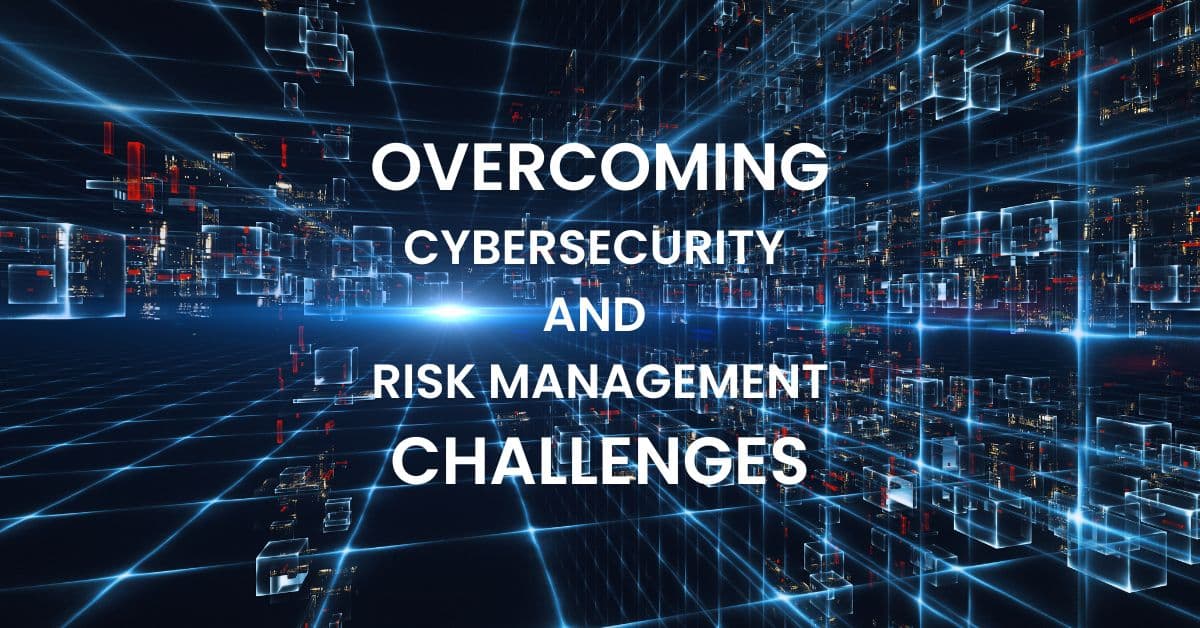Every time you leave your home, you take various risks, like being in a car accident or being struck down by a meteor. In some cases, like the meteor, the likelihood of the event is so low as to be nearly nonexistent. In others, like the car accident, the likelihood might be higher.
Similarly, every technology that you connect to your networks creates a cybersecurity security risk. Any device or application that connects to the public internet can be an entry point for attackers. However, just like the meteor being nearly nonexistent, some cyber risks may be so low as to have little potential impact on your organization’s finances.
In an increasingly digital world, understanding cybersecurity and risk management challenges can help you build a stronger security program based on best practices.
What is Cyber Risk Management?
Cyber risk management is a structured process where organizations identify, assess, and mitigate risks related to their IT environments, including enterprise IT, operating technology (OT), and Internet of Things (IoT) fleets.
The core components of cyber risk management include:
- Identification and analysis: Determining risks arising from people, digital assets, and data and establishing an organizational risk profile.
- Risk mitigation: Implementing and enforcing security and privacy controls that reduce risk and align with the established risk profile.
- Threat Detection: Continuously monitoring to identify new threats that require mitigation.
- Response: Taking action to counteract identified threats and incidents.
- Recovery: Restoring systems back to a known good state after an incident.
What Are the Types of Cyber Risks That Organizations Need to Manage?
While cloud strategies enable organizations to improve productivity and collaboration, they create various cyber risks, and a robust cybersecurity strategy requires understanding these. Increasingly, the Venn diagram of enterprise risk management strategy and cyber risk management is almost a circle.
Data Breaches and Security Incidents
A data breach is a confirmed unauthorized disclosure of sensitive data. Meanwhile, a security incident is an event that compromises data integrity, confidentiality, and availability. In both cases, organizations face business interruption costs as cyber threats cause service outages that make systems, networks, applications, or data unavailable. These cyber risks become even more difficult to manage as threat actors seek to disrupt supply chains by targeting critical and commonly shared vendors.
Privacy
Privacy risks focus more on unauthorized access to data, meaning that organizations need to worry about insiders and external actors. For example, a privacy risk that differs from a data breach or security incident might be a workforce member accidentally sending sensitive information to the wrong email address.
Compliance
Regulatory compliance is often considered a check-the-box requirement that companies need to implement. However, most compliance regulations and frameworks establish a standardized set of minimum security hygiene baselines and best practices. Often, cybercriminals compromise systems by finding a weakness in these controls which correlates to a compliance violation.
The NetDiligence Cyber Claims Study 2024 Report noted the following average cost of regulation action fines:
- $30,000 for 2023.
- $69,000 from 2019 to 2023.
Legal
Related compliance, legal issues often arise from data breaches and other security incidents. Under many data protection laws, people can sue organizations that experience a data breach when it compromised their data. Further, many contracts include cybersecurity clauses that can trigger a civil lawsuit.
According to the NetDiligence Cyber Claims Study, average legal costs for 2023 were:
- $217,000 in legal damages settlement.
- $136,000 in legal damages defense.
The four year average of legal costs between 2019 and 2023 were:
- $137,000 in legal damages settlement.
- $591,000 in legal damages defense.
Reputation/Brand
When organizations experience security or privacy incidents, it impacts how customers view their brand. According to the Cost of a Data Breach 2024 Report, lost business after a data breach cost an average of $1.47 million.
Why is Cybersecurity and Risk Management Challenging?
To say that organizational IT environments are complex would be a gross understatement. As organizations connect various applications that share data, the number of potential attack points increases.
Threat Landscape
According to the 2024 ISC2 Cybersecurity Workforce Study, 74% of cybersecurity professionals say the threat landscape is the worst they’ve seen in the last five years. As organizations integrate Software-as-a-Service (SaaS) applications and application programming interfaces (APIs), attackers seek to exploit them. Meanwhile, artificial intelligence enables them to write more convincing phishing messages that help them steal user credentials. Organizations need to implement the risk mitigation strategies when they adopt these technologies, but tools often only exist after attackers find ways to exploit new vulnerabilities.
Expanding Attack Surface
Related to the changing threat landscape, the expanding attack surface is another challenge that new technologies create. Every new access point on an organization’s network is a potential attack point. From IoT devices to reliance on user credentials, organizations struggle to understand their attack surface and implement the appropriate risk mitigations.
Compliance Landscape
Over the last few years, legislative bodies and standards organizations have tried to keep pace with attackers, too. The bureaucratic slog means that new legislation, regulation, and frameworks are often reactive measures that update security best practices. However, organizations have to comply with these new requirements. Even more challenging, businesses need to comply with regulations for any markets or industries they seek to enter.
The State of GRC 2025 report found the following:
- 52% of respondents are exhausted trying to identify new frameworks.
- 48% of respondents struggle to keep pace with updates to existing frameworks.
- 60% of organizations manage at least five frameworks.
Staffing Constraints
The cybersecurity skills gap remains a fundamental challenge for organizations trying to manage their security risks. The 2024 ICS2 Cybersecurity Workforce Study noted:
- 92% of respondents reported skills gaps in their organizations.
- 64% of respondents believed skills gaps can be worse than staffing shortages.
- 35% of respondents said they have both skills gaps and staffing shortages.
Problematically, organizations have a hard time hiring skilled professionals because they command a higher salary. Meanwhile, the less experienced analysts are willing to accept a lower salary but lack the skills needed to mitigate risk.
Budget Constraints
Every organization faces budgeting challenges, especially when trying to manage competing internal interests. Even more difficult, cybersecurity risk management can often be viewed as a cost center. When organizations have no insight into how their security posture directly relates to revenue growth, they may be less likely to prioritize hiring new staff or purchasing new tools.
Quantifying Risk
For many organizations, risk seems unstructured. Attackers may or may not target the company. A security control may or may not fall out of compliance or fail. A tool may or may not be optimized. Working with probabilities and likelihoods means that organizations often feel as though they are making qualitative best guesses rather than quantifying risk in meaningful ways based on revenue impact.
Best Practices for Cyber Risk Management
Cyber risk management is increasingly critical for organizations, especially when they struggle to maintain slim profit and operating margins. However, implementing some best practices can mitigate risk while providing customers with assurance over your security posture, enabling you to improve your revenue.
Identify a Risk Management Framework
Every organization is different, and every organization’s risks are unique, even when some are nearly universal. Organizations in heavily regulated industries or classified as critical infrastructure have specific regulatory requirements. In other cases, organizations choose a cyber risk framework that meets their needs. Some examples of risk frameworks or compliance requirements include:
- Payment Card Industry Data Security Standard (PCI DSS)
- Organization for Standardization (ISO) standards ISO 27000 and ISO/IEC 27001
- Federal Energy Regulatory Commission (FERC) and the North American Electric Reliability Corporation (NERC)
- Directive on Security of Network and Information Systems (NIS2)
- Digital Operational Resilience Act (DORA)
- National Institute of Standards and Technology (NIST) Cybersecurity Framework (NIST CSF)
- Center for Internet Security (CIS) Controls
Identify Risks
Most compliance frameworks define the types of cyber risks that you need to consider. However, at a high level, these risks fall into a few broad categories:
- People: Users have access to sensitive data so you need to ensure that only the right people have the right access and only for the amount of time they need it, like limiting privileged accounts to just-in-time access.
- Data: Sensitive data poses the highest risk to your organization, so you should be able to categorize and identify all personally identifiable information (PII), payment card data, protected health information, and user credentials.
- Devices: Devices with malware installed pose a risk to your systems, networks, and data so you should consider all endpoints, including servers, network devices, mobile devices, and IoT devices.
- Networks: Network vulnerabilities offer another threat actor entrance point, so you need to consider network access and data transmission risks.
- Applications: The applications that your workforce members use often have public internet functionalities which give attackers an opportunity to compromise their data, so you should consider access to applications, including limiting user access within the applications and monitoring the APIs.
Review Security Controls and Gaps
Most organizations have some security controls in place. For example, nearly every application requires a username and password. As you build out your security risk management program, you should work from the identified risks and then implement controls that reduce the likelihood of attackers successfully completing their objectives or limit the impact that an attack can have. Once you have a set of controls listed, you can look to your chosen risk framework and identify gaps.
Centralize All Security Data and Activities
By consolidating all security telemetry and activities in a single location, you can correlate the data that your environment and security tools generate. Typically, organizations collect a variety of security tools to help them address different risks, like Identity and Access Management (IAM) solutions for user access, monitoring tools for APIs, or firewalls for managing network traffic. Aggregating this data enables you to enrich it for improved visibility.
Create Detections and Alerts
Detecting new threats is another fundamental requirement for your cybersecurity risk management program. To respond to evolving threats, you need to understand attacker tactics, techniques, and procedures (TTPs), essentially their attack methodologies. For example, if you combine Sigma rule detections with the MITRE ATT&CK framework TTPs, you can build high-fidelity alerts that reduce risks arising from false positive and alert fatigue.
Build Management Reports
Evaluating the risk management initiative and communicating its effectiveness enables senior leadership and the board of directors to make informed decisions about future investments. These reports should include insight into security trends over time, like insights into key performance metrics or threat coverage that shows how well your security controls map to known threat types.
Graylog Security: Centralized Cybersecurity Risk Management Visibility and Reporting
Built on the Graylog Platform, Graylog Security gives you the features and functionality of a SIEM while eliminating the complexity and reducing costs. With our easy to deploy and use solution, you get the combined power of centralized log management, data enrichment and normalization, correlation, threat detection, incident investigation, anomaly detection, and reporting.
With Graylog’s prebuilt content, you don’t have to worry about choosing the server log data you want because we do it for you. Graylog Illuminate content packs automate the visualization, management, and correlation processes for you.
To see how Graylog can help you improve your security program and help you manage APTs more effectively, contact us today.


